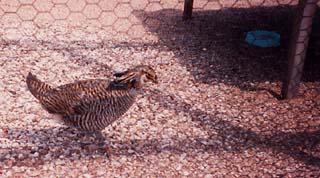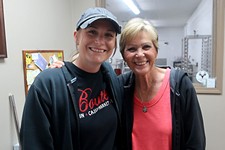Day Trips
Eagle Lake rallies around the endangered Attwater's Prairie Chicken population with its annual festival.
By Gerald E. McLeod, Fri., March 31, 2000

The Attwater's Prairie Chicken is one of the most endangered birds in the United States. The golden, grouse-like little bird once numbered in the millions on the coastal plains of Texas and Louisiana. Today, official counts in three Texas counties estimate that there are 46 of the birds left in the wild; add to that another 100 or so in captive breeding programs.
Historic accounts by early Texas settlers tell of the male mating call, similar to the sound of blowing over the top of a soda bottle, so loud that it hurt their ears, says Terry Rossignol, a ranger at the Attwater's Prairie Chicken National Wildlife Refuge outside of Eagle Lake. Despite the intervention of science, the number of birds in the wild has been slow to rise.
The city of Eagle Lake celebrates the hope of life for the birds with the annual Prairie Chicken Festival, April 7-9. The residents invite the carnival to town, and the town square fills with food, crafts, and educational booths. Kids enjoy the petting zoo, a chance to build their own bird feeder, and games.
The festivities go all day until the last "Chicken Dance" at the street dance. Under the nature tent the state, federal, and private wildlife agencies show their efforts to preserve and protect native Texas habitat and wildlife. The highlight of the weekend is free guided tours of the refuge every hour between 7am and 4pm on Saturday and Sunday.
"Last year at the festival the early tours were treated to a spectacular show by the birds," Rossignol says. "As sure as I say that the birds won't show up at the booming grounds. There are no guarantees."
Usually off-limits to visitors, the booming grounds are a small portion of the more than 8,000-acre sanctuary where the birds meet to perform their mating calls and dances. Besides the booming call, the males have bright red glands on their necks that they puff up like cheeks as they strut around.
The refuge is also home to a great assortment of other birds and a herd of buffalo. "Plus we should have a spectacular array of wildflowers by then," Rossignol adds.
Established in 1972, the U.S. Fish & Wildlife Service refuge encompasses one of the last large stands of virgin prairie in Texas. Another 2,500-acre preserve is maintained by the Nature Conservancy in Galveston County. It was the loss of this type of habitat to agriculture, industrialization, and urbanization that has brought the Attwater's Prairie Chicken to the brink of extinction.
Spring is the time the birds begin mating and the time when the biologists at the refuge begin their annual census. They won't know until May how many of the 100 birds released last year have survived.
Captive breeding facilities at the Houston Zoo, the San Antonio Zoo, Fossil Rim Wildlife Center, Texas A&M, and Sea World-San Antonio contribute to the annual release held in late August and early September.
Unfortunately, the mortality rate for the captive-bred birds is very high. With an average of 60 birds a year reintroduced to the wild since 1992, as few as 18% have survived to the next spring. The odds against the birds are so great that it is considered a good year when 45% of the new arrivals survive for a year.
After dipping to an estimated low of 42 birds in 1996, the wild population of prairie chickens rebounded to a decade high of 58 the next year. Weather, predators, disease, and scarce food contribute to the fluctuation in numbers. Once dependent on grazing bison to keep native prairie grasses at an ideal height and density, the birds can coexist with cattle.
A positive note on the prairie chicken's future has been the implementation of "safe harbor agreements" between the Fish & Wildlife Department and local landowners. At the beginning of the agreement period, the government establishes a baseline of how many prairie chickens the land currently supports. From there, both parties work to improve the habitat over a 10-year period. At the end of the agreement the landowners are free from future liabilities as long as they maintain the baseline population.
The birds get additional habitat at a time when every acre is important to the survival of the species, while ranchers get help improving their pastures. The program has restored more than 18,000 acres of habitat on private land. "Landowners are key to the long-term survival of the prairie chicken," Rossignol says.
The Texas Parks and Wildlife Department's Adopt-a-Prairie Chicken program gives the public an avenue to get personally involved by helping to fund the care of the chicks. For $25, the member receives progress reports, a photo of their chick, opportunities to visit the captive breeding facilities, invitations to a summer release, and other items. Call 800/792-1112 for more information.
The Attwater's Prairie Chicken Wildlife Refuge covers a beautiful cross-section of coastal environments besides the tallgrass prairie. An excellent birding and wildlife-spotting area, the preserve opens to the public on weekdays from sunup to sunset. There is no admission charge to tour the visitor center, hike the two trails, or take the five-mile driving tour through the park. There are no camping facilities at the park, and pets must be on a leash. For more information, call 979/234-3021.
The refuge is about 6.5 miles northeast of Eagle Lake off FM 3013. The scenic little town is known for duck hunting for part of the year, but offers ample guest service year-round. For more information on the festival or accommodations, call 409/234-2780 or on the Web at http://www.elc.net/chamber.
Coming up this weekend ...
FolkFest in New Braunfels' Conservation Plaza and Museum of Handmade Furniture brings life back to the historic buildings with a weekend of entertainment, April 1-2. 830/629-2943.
Roughneck Chili & Barbecue Cookoff in Luling mixes the sweet smell of cooking and gas for a day of foolery, April 1. 830/875-3214.
Coming up ...
DeWitt County Wildflower Month offers self-guided tours around the county lanes and byways with information and maps available in Cuero from the County Historical Museum, 312 E. Broadway through April. 361/275-9942.








